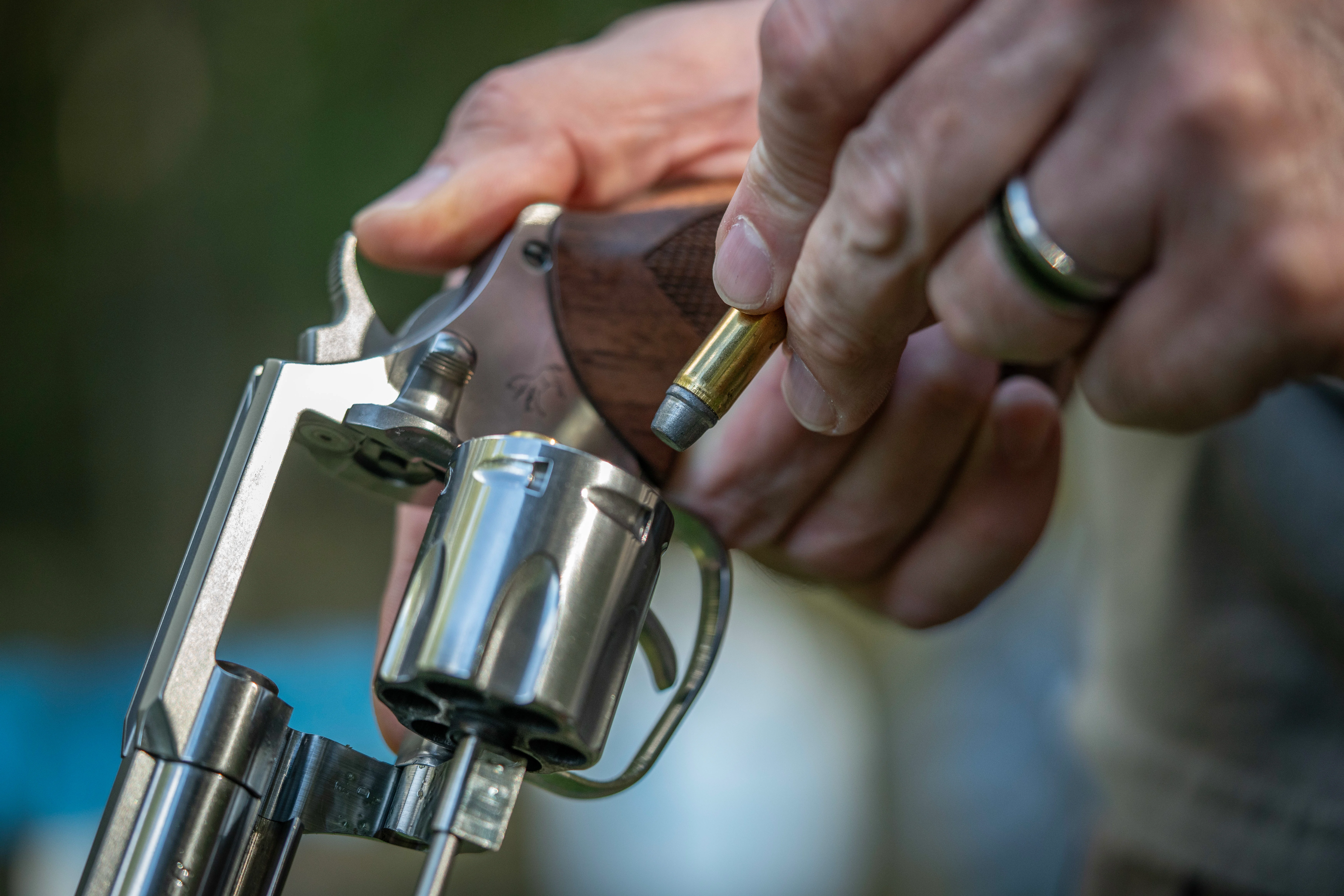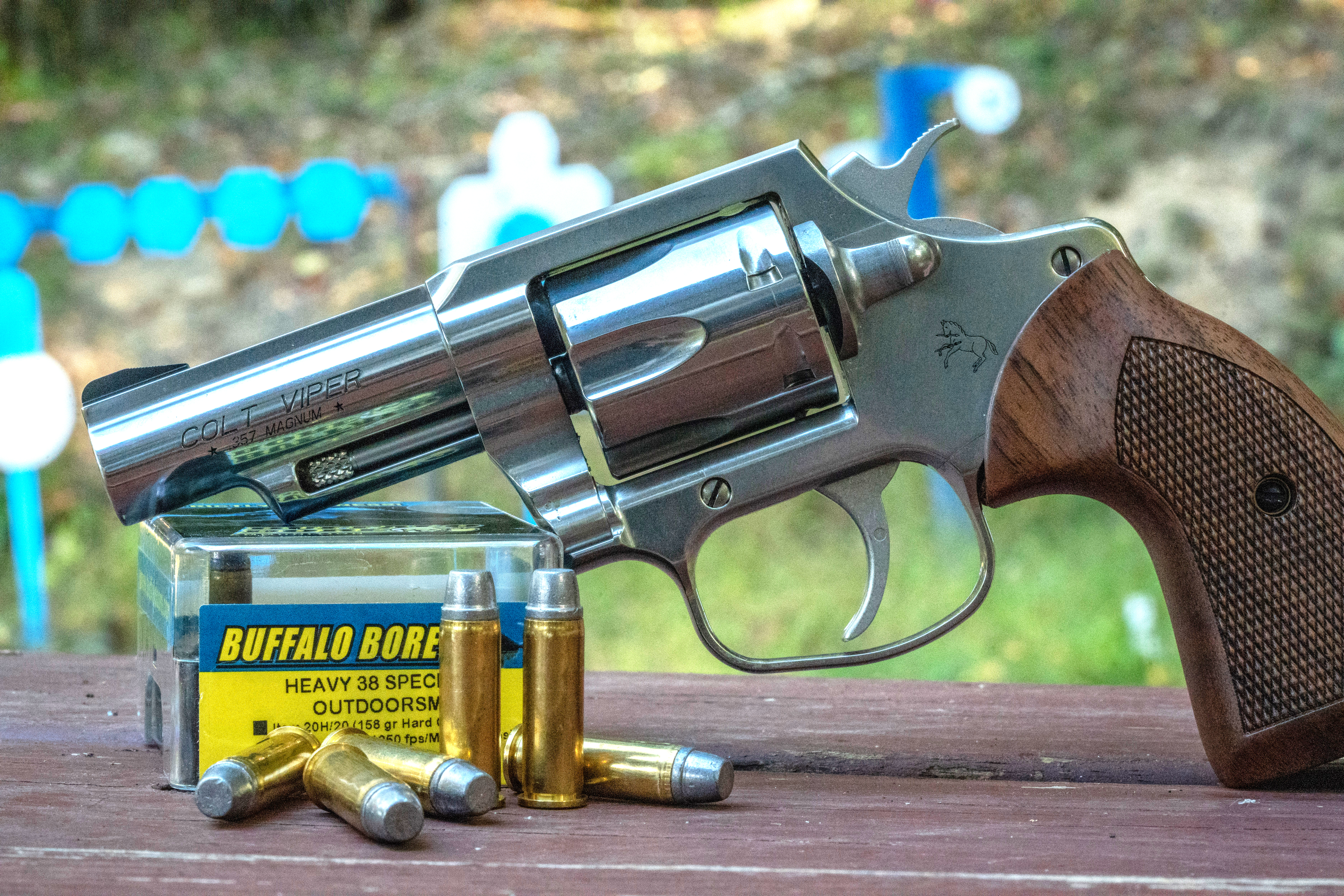When Colt reintroduced their iconic Python in 2020, revolver aficionados were delighted, and in 2023 we tested the 3-inch version of the Python and selected it as the best handgun for an outdoorsman. Now in 2024, Colt has reintroduced another of their classic revolvers—the Viper—and they’ve also upgraded it to handle the 357 Magnum. Colt’s Viper might not be as iconic as the Python, but we think it could serve admirably on the trail and around camp, and the Viper costs about $500 less than the Python.
I got a chance to put a new Viper through the wringer at my home range recently. Here's my full review.
Colt Viper Specs
Length: 7.8 inches
Weight: 27.3 ounces
Barrel: 3.0 inches (4.25-inch barrel is optional)
Action: Double action
Trigger: Single Action: 4.0 pounds, double Action: 8 pounds (as tested)
Capacity: 6
Finish: Polished stainless steel
Stock: Walnut
Chamberings: 357 Magnum/38 Special
Price: $999
Colt Viper Overview

Colt is offering two versions of the reintroduced Viper. There is a 3-inch and a 4.25-inch version, and both have frames sized the same as Colt’s legendary Python. But there are some notable differences between the Viper and the Python. There are also some differences between the new Viper and the original Vipers from the 70s and 80s.
Unlike the Python, which has a full-length underlug and ribbed barrel, the Viper has a half-lugged barrel and is rib free. Aside from the barrel profile, the main difference between the Viper and the Python is the sights. Pythons come with a fully adjustable rear sight and a front sight with Tritium or a colored insert. The rear sight on the Viper is integral to the frame and is nothing more than a trough that runs the length of the revolver’s top strap. This trough pairs with a fixed, black blade front sight, and though the combination is very basic, it does provide a sight picture that will allow reasonably accurate shooting.
As for the variances between the new and old Vipers, original Vipers had an aluminum frame and were available in 38 Special. The new Vipers have a stainless-steel frame and are compatible with 38 Special and 357 Magnum ammunition. Colt also modified the Viper’s trigger guard, making it a bit larger than the original, and new Vipers are almost identical to the also-new Colt King Cobra revolvers. Though some of the King Cobra revolvers come with adjustable sights and a ribbed barrel, the primary difference is the full underneath lug on the barrel, which makes King Cobras a bit heavier.
Related: Best Handguns for Hunting
Colt Viper Test Results

During my testing, the thing that impressed me the most about the Colt Viper was the trigger. Most double-action revolvers will have a double-action trigger pull exceeding 10 pounds. The double-action pull on the Viper was right at 8 pounds and only had minimal stacking near the end of the press. The single-action trigger pull was not bad either; it took right at 4 pounds of pressure to release the hammer, but the trigger was crisp and without an excessive amount of overtravel.
The Viper’s sights are nothing to brag about, but I shot the revolver well, with groups at 10 yards averaging less than 1.5 inches, which is decent from a 3-inch barrel. I think the Viper’s good trigger was the primary reason I shot it as well as I did. During more dynamic shooting, using the double-action mode, I was able to draw from Galco’s excellent Combat Master holster and routinely get two hits on an 8-inch plate at 20 yards in less than six seconds. (Note: The Colt Viper and King Cobra will work with the same holster, but some holster manufactures might only list a holster for the King Cobra. Keep this in mind when you’re shopping.)

I did find the modified trigger guard to be a bit large at the rear. The first knuckle of the middle finger on my shooting hand uncomfortably pressed against the rear of the trigger guard when I had a good shooting grip. My hands—and knuckles—are on the larger side, and if yours are too, you may want to go with a different set of grips. The Viper was comfortable to shoot with most 38 Special loads, but with a heavy-hitting Buffalo Bore 38 Special load and full-power 357 Magnum loads, it twisted the wrist and numbed the hand a bit. Remember, this revolver only weighs 27 ounces.

Like with many revolvers chambered for the 357 Magnum, sometimes the short ejector rod will struggle to fully press 357 Magnum cases from the cylinder, and with full power loads they can sometimes be a bit sticky. I only mention this for those who might be buying their first 357 Magnum revolver, because it’s not uncommon. You might have to be a bit forceful with the ejection rod to pop fired 357 empty cases out of the cylinder. With the Viper, a firm press with the thumb was enough, though on occasion an empty would impact the forward edge of the grip and require a shake to dislodge. However, 38 Special empties—even those from the hot loaded Buffalo Bore loads—popped right out, and gravity was enough to pull out the empties from standard pressure 38 Special loads.
Related: How to Pick the Best Handgun Caliber for Hunting
Final Thoughts on the New Colt Viper

Pros
Compact
Accurate
Rugged
Cons
Rudimentary sights
When it comes to double-action revolvers of a comparable size and quality, Ruger offers a 3-inch barreled SP101 in 357 Magnum. It weighs the same as the Viper but only holds five rounds. Ruger’s 3-inch GP 100 holds six rounds but costs an additional $150 and is 10-ounces heavier. Smith & Wesson’s 3-inch Model 60 is about $150 less than the Viper and is slightly lighter, but like the SP101 it’s a five-rounder. Smith & Wesson’s 686 Plus holds seven rounds of 357 Magnum, and it comes with adjustable sights, but it’s a full 10 ounces heavier than the Viper and more expensive. All of this to say that Colt’s new Viper fills a price, size, and capacity void in the mid-sized 357 Magnum double-action revolver market—and one that might suit you just right.
I think the new 3-inch Viper is just about ideal for comfortable holster carry in the field. The barrel is not so long to make sitting inconvenient, and with a good holster, you’ll forget it’s on your side. And the Viper’s trigger and precision will allow accurate shooting out to 25 yards or so. A downside are the non-adjustable sights, but the benefit they offer is that they’re as rugged as an anvil. Also, out-of-the-box the revolver shot to point of aim or just a smidgen high with most loads. Any hunter, fisherman, or outdoorsman in the market for a practical and rugged, wilderness ready, trail gun should give Colt’s Viper a serious look. It’s $500 less expensive than Colt’s Python and $500 will buy a lot of ammunition.



